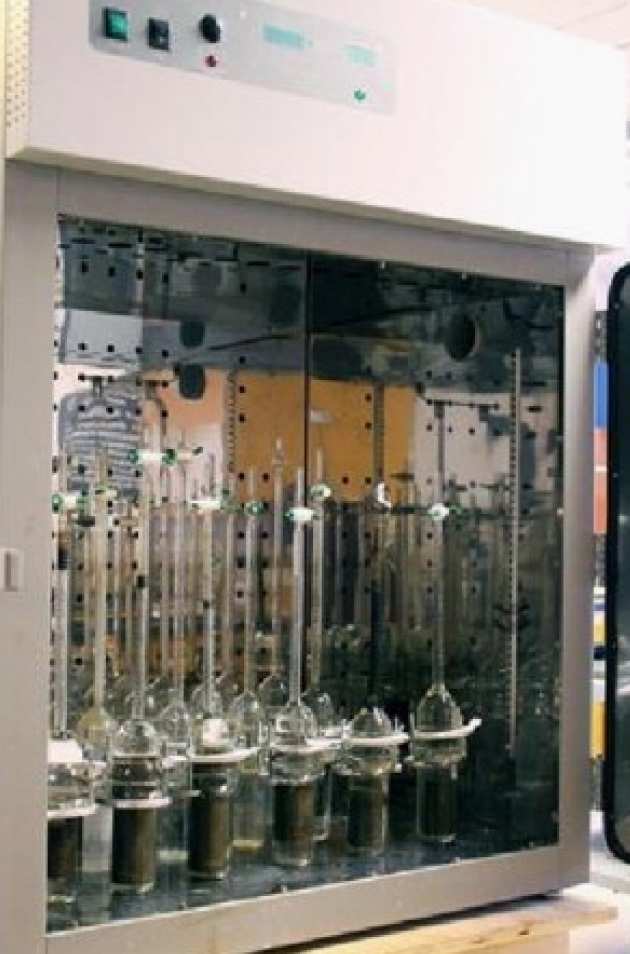
It is widely accepted that oil recovery can be improved by modifying the composition of the brine (saline water) that is injected into the reservoir to displace the oil. This process is termed ‘Controlled Salinity Waterflooding’ (CSW). The NORMS group uses bespoke experiments and models to understand and predict the underlying mechanisms and optimum injection brine composition.
We use the specialist facilities in the Norms Laboratory to measure and determine the link between changes in zeta potential (the electrical charge at mineral-brine and oil-brine interfaces) and improved recovery during CSW. The zeta potential is important, because it dictates the magnitude and polarity of the electrostatic forces that act between the interfaces. We have shown that improved recovery is strongly correlated with changes in zeta potential. A unique aspect of our experimental methodology is that we measure zeta potential during CSW experiments, so samples and experimental conditions are the same. We work with a wide range of oil and gas companies such as BP and TOTAL.
 Far Left: Water spontaneously imbibes into a rock core sample during a CSW experiment, expelling the oil which forms droplets on the rock surface.
Far Left: Water spontaneously imbibes into a rock core sample during a CSW experiment, expelling the oil which forms droplets on the rock surface.
Left: Array of spontaneous imbibition experiments at elevated temperature
Selected NORMS group publications on CSW
Vinogradov J, Jackson MD, Chamerois M, 2018, Zeta potential in sandpacks: Effect of temperature, electrolyte pH, ionic strength and divalent cations, COLLOIDS AND SURFACES A-PHYSICOCHEMICAL AND ENGINEERING ASPECTS, Vol: 553, Pages: 259-271, ISSN: 0927-7757
Al Mahrouqi D, Vinogradov J, Jackson MD, 2017, Zeta potential of artificial and natural calcite in aqueous solution, ADVANCES IN COLLOID AND INTERFACE SCIENCE, Vol: 240, Pages: 60-76, ISSN: 0001-8686
Al Mahrouqi D, Vinogradov J, Jackson MD, 2016, Temperature dependence of the zeta potential in intact natural carbonates, GEOPHYSICAL RESEARCH LETTERS, Vol: 43, Pages: 11578-11587, ISSN: 0094-8276
Alroudhan A, Vinogradov J, Jackson MD, 2016, Zeta potential of intact natural limestone: Impact of potential-determining ions Ca, Mg and SO4, COLLOIDS AND SURFACES A-PHYSICOCHEMICAL AND ENGINEERING ASPECTS, Vol: 493, Pages: 83-98, ISSN: 0927-7757
Jackson MD, Al-Mahrouqi D, Vinogradov J, 2016, Zeta potential in oil-water-carbonate systems and its impact on oil recovery during controlled salinity water-flooding, SCIENTIFIC REPORTS, Vol: 6, ISSN: 2045-2322
Jackson MD, Vinogradov J, Hamon G, et al., 2016, Evidence, mechanisms and improved understanding of controlled salinity waterflooding part 1: Sandstones, FUEL, Vol: 185, Pages: 772-793, ISSN: 0016-2361
Vinogradov J, Jackson MD, 2015, Zeta potential in intact natural sandstones at elevated temperatures, GEOPHYSICAL RESEARCH LETTERS, Vol: 42, Pages: 6287-6294, ISSN: 0094-8276
Jackson MD, Vinogradov J, 2012, Impact of wettability on laboratory measurements of streaming potential in carbonates, COLLOIDS AND SURFACES A-PHYSICOCHEMICAL AND ENGINEERING ASPECTS, Vol: 393, Pages: 86-95, ISSN: 0927-7757
Vinogradov J, Jaafar MZ, Jackson MD, 2010, Measurement of streaming potential coupling coefficient in sandstones saturated with natural and artificial brines at high salinity, JOURNAL OF GEOPHYSICAL RESEARCH-SOLID EARTH, Vol: 115, ISSN: 0148-0227